Are you a Quiet Speculation member?
If not, now is a perfect time to join up! Our powerful tools, breaking-news analysis, and exclusive Discord channel will make sure you stay up to date and ahead of the curve.
New sets often pique the interest of Modern players. My last article discussed about how Rivals of Ixalan has brought quite a bit of excitement for Merfolk in Modern. This time around, we'll see how the set's tribal theme might have improved archetype that has been biding its time in Modern for a long while. Vampires have received special attention in Rivals, and I believe some of their new ranks have made it worthwhile to seriously explore the deck in this format.
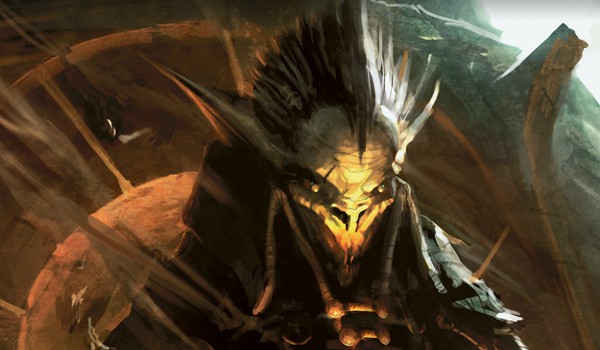
This article details how Vampires have received additions to the card pool over time, ponders why Rivals of Ixalan might be a tipping point for the archetype's viability, and presents the list I have been testing with over the past week.
A Brief History of Vampires in Modern
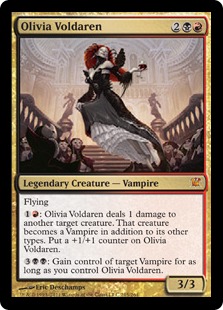 Vampires have almost exclusively made their Modern impact via powerful stand-alone cards like Kalitas, Traitor of Ghet and Olivia Voldaren, rather than in a synergistic tribal deck. However, both Innistrad blocks and some cards in Magic 2011 and 2013 have pushed the concept of Vampires as a cohesive archetype in the vein of Elves or Merfolk. Creatures such as Vampire Nocturnus and Stromkirk Captain suggested that once the tribe accumulated a critical mass of cheap, efficient creatures like Gifted Aetherborn, it would have enough Vampire-specific payoffs to make a dedicated tribal deck a possibility.
Vampires have almost exclusively made their Modern impact via powerful stand-alone cards like Kalitas, Traitor of Ghet and Olivia Voldaren, rather than in a synergistic tribal deck. However, both Innistrad blocks and some cards in Magic 2011 and 2013 have pushed the concept of Vampires as a cohesive archetype in the vein of Elves or Merfolk. Creatures such as Vampire Nocturnus and Stromkirk Captain suggested that once the tribe accumulated a critical mass of cheap, efficient creatures like Gifted Aetherborn, it would have enough Vampire-specific payoffs to make a dedicated tribal deck a possibility.
On the subject of colors, there was little doubt that black would be the deck's dominant color. The vast majority of the Vampires printed are black, and many charge multiple black mana symbols. When considering other colors, the red splash was the most common choice. Only token producers like Sorin, Lord of Innistrad provided reasons to look elsewhere.
As of of Ixalan, however, cards like Adanto Vanguard, Legion's Landing, and Mavren Fein, Dusk Apostle made white a significantly more appealing option, which somewhat complicates finding the optimal configuration of the deck. Ixalan also pushed the tribe into more of a token-generation direction; however, I am deeply skeptical of a Vampire-themed, token-based strategy being fast or powerful enough for Modern given the fringe status of WB Tokens (which features stronger token generators and better payoffs).
Vampire Cards in Rivals of Ixalan
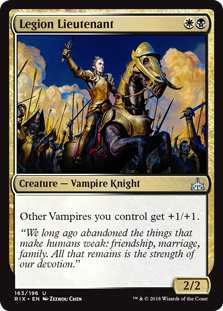 The first standout card in Rivals for Vampires is Legion Lieutenant. While it does lock you into splashing white, it's also a very promising tribal payoff card. Decks like Merfolk have long demonstrated the power of lord effects, and Lieutenant is the cheapest such effect available to Vampires.
The first standout card in Rivals for Vampires is Legion Lieutenant. While it does lock you into splashing white, it's also a very promising tribal payoff card. Decks like Merfolk have long demonstrated the power of lord effects, and Lieutenant is the cheapest such effect available to Vampires.
Another potential white spell is Forerunner of the Legion; a utility three-drop with a tutor effect as it enters the battlefield is a fairly reasonable rate, especially in a tribal deck which benefits greatly from continually drawing relevant cards in the midgame.
Oathsworn Vampire is yet another. Provided that Oathsworn's condition can be met, a recurring threat will always be handy for an aggressive tribal strategy, and the body is decent for the cost. However, this card almost demands a deck built around lifelink effects in order to reliably meet its condition, so the deckbuilding requirements are a bit steep.
The final interesting Vampire from Rivals is Dusk Legion Zealot. While its 1/1 body is quite unimpressive, many tribal decks have made good use of a creature that provides an on-tribe body to project +1/+1 effects onto that also draws an extra card. Of the cards discussed thus far, this is the one I feel most confident will make an impact on tribal Vampire decks due to its similarities with Silvergill Adept, arguably the most critical creature in Merfolk.
Presenting the Test Deck
After examination of the available cards and some discussion, I settled on this list.
Mono-Black Vampires, by Roland F. Rivera Santiago
I chose to keep the deck mono-black as opposed to incorporating any of the previously discussed splashes. The major reason why I did so is the mana—this deck is pretty heavy on black requirements, and I was somewhat leery of trying to jam a second color. I did attempt to do so, but kept finding that the fastlands I wanted hindered my ability to cast four-drops on curve, and limited the number of land spots for utility and manlands.
Card Choices
Here's a brief summary of my card choices. My priorities in deckbuilding were to emphasize consistent openers, and ensure that the deck has a steady supply of threats on the battlefield. The curve is very similar to what you'd find in a Merfolk deck, and that is by design; I wanted to start with a deck type that had a good chance of working, and then adjust as necessary.
Creatures
Viscera Seer: Seer generates value from creatures in response to removal. It can also dig for a black card to put on top of your library for Nocturnus. Overall it's not amazing, but playable given the mostly subpar options at the one-drop spot.
Asylum Visitor: This card is good at pressuring opponents early thanks to its 3/1 body, and can also be relevant in the midgame thanks to its card-drawing ability. Lastly, the madness ability can lead to some sneaky situations with Stromkirk Condemned in which you can flash the body in at instant speed to devastating effect.
Bloodghast: An on-tribe body that makes the deck more resilient to spot removal. It also has some cute synergies with Collective Brutality, Stromkirk Condemned, and Viscera Seer.
 Captivating Vampire: Lord effects make Bloodghast all the more intimidating, but Captivating also boasts the unique ability to break board stalls against opponents light on spot removal. Or just steal a Reality Smasher.
Captivating Vampire: Lord effects make Bloodghast all the more intimidating, but Captivating also boasts the unique ability to break board stalls against opponents light on spot removal. Or just steal a Reality Smasher.
Dusk Legion Zealot: An on-tribe body that replaces itself, à la Elvish Visionary or Silvergill Adept.
Gifted Aetherborn: Trades up with beefier creatures, helps stabilize against faster aggro decks, and wins races, especially with some pumps.
Stromkirk Condemned: A recurring source of pump. Its cost can sometimes benefit us.
Vampire Nocturnus: Our primary payoff spell. +2/+1 and evasion is a massive tribal payoff, and while it can sometimes be a bit unreliable in terms of having the effect switched on, the deck is built around meeting its condition.
Spells
 Aether Vial: Vial makes sense in this deck for a variety of reasons. Primarily, this deck is centered around two-drops (as the selection of one-mana Vampires is rather poor), so a one-mana accelerant makes a lot of sense. Vial's downside of being a dead topdeck later can also be mitigated by the deck's discard outlets.
Aether Vial: Vial makes sense in this deck for a variety of reasons. Primarily, this deck is centered around two-drops (as the selection of one-mana Vampires is rather poor), so a one-mana accelerant makes a lot of sense. Vial's downside of being a dead topdeck later can also be mitigated by the deck's discard outlets.
Collective Brutality: Brutality serves as maindeck interaction against spell-based opponents, randomly creams spell-and-creature decks like Burn and Company, and even offers a bit of reach to close games out with.
Fatal Push: Bread-and-butter removal spell. Not much to say here other than any deck running black should consider it.
Lands
Bloodstained Mire: Mire serves several purposes in this mono-black shell. The most important function is to provide on-demand revolt triggers for Fatal Push. Mire also provides an on-demand source of landfall triggers for Bloodghast, which Viscera Seer can even use as a recurring sacrifice outlet. Lastly, in the event that Vampire Nocturnus reveals a nonblack card on top of the library, fetching provides a shuffle.
Urborg, Tomb of Yawgmoth: Simplifies meeting the deck's tough black mana requirements despite 4 Mutavault, and lets fetchlands tap for black without being cracked. Drawing the second copy is rarely an issue, thanks to the discard outlets.
Sideboard
 Fulminator Mage: Slows down big mana decks, and perhaps pops a manland or two in a pinch.
Fulminator Mage: Slows down big mana decks, and perhaps pops a manland or two in a pinch.
Nihil Spellbomb: Standard graveyard hate. I chose Nihil over Relic of Progenitus largely because I wanted to avoid any potential awkwardness with Bloodghast.
Thoughtseize: A concession to combo and big mana decks, this card comes in anytime the deck needs more disruption.
Dismember: Takes down targets Push and Brutality struggle against, chiefly the Eldrazi and delve creatures.
Testing Results
I tested the deck against a somewhat abbreviated gauntlet of competitive Modern decks. The decks I encountered included Affinity, Eldrazi Tron, Gx Tron, Grixis Shadow, Gifts Storm, and Mardu Pyromancer. Coming in, I expected the deck to do well against Shadow by virtue of being a go-wide creature deck; struggle against Tron variants because of the relative paucity of land hate; and enjoy various degrees of success against the rest of the field. My assumptions mostly held true, with a couple exceptions.
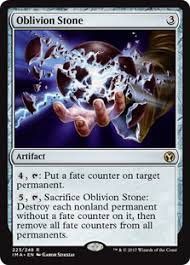 Grixis Shadow is a very straightforward matchup for Vampires—despite its ability to disrupt creature-based synergies and present beefy blockers, Shadow is poorly suited to deal with a constant stream of attackers, especially if its blockers can be removed. Vampires is good at both of those things, and thus good against Shadow. Due to the attrition nature of the matchup, Aether Vial should be benched in favor of Nihil Spellbomb, as Spellbomb is important and the Vial is a lousy topdeck late. I feel that similar tools would be applicable when facing the aggro-slanted Delirium Shadow deck, as Push and Spellbomb are even more effective against Tarmogoyf than against Gurmag Angler.
Grixis Shadow is a very straightforward matchup for Vampires—despite its ability to disrupt creature-based synergies and present beefy blockers, Shadow is poorly suited to deal with a constant stream of attackers, especially if its blockers can be removed. Vampires is good at both of those things, and thus good against Shadow. Due to the attrition nature of the matchup, Aether Vial should be benched in favor of Nihil Spellbomb, as Spellbomb is important and the Vial is a lousy topdeck late. I feel that similar tools would be applicable when facing the aggro-slanted Delirium Shadow deck, as Push and Spellbomb are even more effective against Tarmogoyf than against Gurmag Angler.
The Affinity and Storm matchups were better for Vampires than I expected them to be. We have enough spot removal to keep those decks off-balance long enough for our own clock to finish the game. That holds especially true post-board, when we've got playsets of Brutality and Push alongside Dismember in the case of Affinity, or Spellbomb and Thoughtseize against Storm.
Vampires also proved surprisingly competent against Eldrazi Tron; while I lost any game in which my opponent was able to untap with Endbringer, I also won games in which the deck backed up an early clock with some removal, or ones in which my opponent didn't find removal and Captivating Vampire took over the battlefield. One highlight was a game in which I was able to snatch a Thought-Knot Seer and a Matter Reshaper from my opponent, and used them plus a couple of Mutavaults to close a game out through a resolved All is Dust.
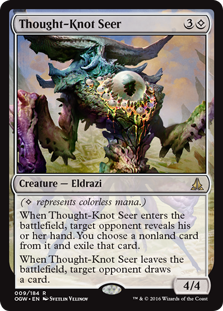
On the negative side, the Tron matchup was every bit as rough as I expected it to be. Ugin, the Spirit Dragon and Oblivion Stone in particular are an absolute beating, and Wurmcoil Engine typically forces us to win on the following turn... or else. Mardu also proved to be somewhat of a struggle, especially if Vampires happened to draw more than four lands in any given game. That said, the games in which the deck drew the appropriate amount of lands felt eminently winnable. In spite of these matchup pitfalls, the deck won enough games against the field that I still think it has potential.
Overall, the matchup profile diverged a bit from other fish tempo decks like Merfolk or Humans—Vampires trades in points against big mana strategies in order to be more solid against aggro-combo. Provided that the deck can hold its own against midrange and control as Merfolk and Humans do, the matchup profile exhibits enough of a divergence in order to provide Vampires with a unique niche.
Further Testing
I want to take this opportunity to qualify all of my matchup assessments by mentioning that my testing is preliminary, and thus my impressions of the matchups require more data in order to be definitive. While I strove to be objective in my evaluation of how the deck performed, my sample is limited, and variance can always play a role.
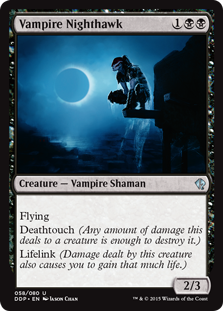
The deck is very much a work in progress. While I feel confident that centering the deck around Vampire Nocturnus and incorporating Dusk Legion Zealot were the right choices, I would love to further test cards like Legion Lieutenant or Stromkirk Captain. Setting aside the splash colors, cards like Gatekeeper of Malakir, Kalastria Highborn, and Vampire Nighthawk did not make the cut in my 75, but perhaps they should have. I'm also questioning whether Fulminator Mage is doing enough to earn its keep; it doesn't seem to be enough to make a difference in the Gx Tron matchup, and Vampires seems capable of putting together a board state that can beat back Eldrazi Tron.
If you have any ideas on those fronts or comments about the deck in general, drop me a line in the comments. Until then, hopefully Vampires suck (or, don't) in your hands as much as they do in mine!





There must be some version of tribal vampires where Blood Artist is good, right?
Probably an Aristocrats-type build. But I’d argue the best possible version of that deck isn’t really Vampire Tribal, since you’d want Zulaport Cutthroat and other value creatures to fuel it.
I’ve been testing a BW Vampire list with fairly promising results. Splashing white gives the deck access to Legion Lieutenant, Path to Exile, excellent sideboard options, and arguably one of the best 1cmc vamps, Skymarcher Aspirant. I’ve been playing with the 1 drop slots, while cutting Vial altogether. Skymarcher Aspirant has been unexpectedly great, as getting Ascend is pretty easy with a low curve. The other cards I’m testing in the 1cmc slots are Legion’s Landing(helps get ascend faster and allows me to shave a land or two), Vicious Conquistador(not terrible), and Vampire Lacerator(pretty decent, but a huge liability against burn). Having maindeck path helps against Wurmcoils/big doods, and the sideboard cards white brings to the table are worth the hit to the mana base. While you lose the big Nocturnus payoff, you get a mana efficient lord and silver bullet sideboard cards for some of our hardest match-ups. From my initial testing, it seems like taking advantage of the low curve has a faster clock than trying to get fancy with Vial and a bunch of 2/3/4 drops. Just my thoughts. Great article and I appreciate the brewing!
I don’t think running Path over Push is worth making your manabase worse, but Skymarcher Aspirant seems like it’s at least worth a look. There is certainly enough volume of Vampire 1-drops to play that low-to-the-ground aggro playstyle, but does it really perform at a higher level than any of its fast aggro comps (think Affinity, Elves, Goblins, etc.)? I’m skeptical, but I’d love to talk about it.
What about gatekeeper of malakir?
Seems great!
Gatekeeper is certainly a consideration. I didn’t include it in the original 75 because kicker doesn’t play nice with Vial, but it’s a nice answer to big fatties like what Tron and Titanshift can bring to bear. Good call.
I’ve started to test a similar approach but with Red and White splash for Captain / Lieutnant / Terminate MD + RIP / Stony in SB.
Here what I’m testing :
3 Swamp
3 Blackcleave Cliffs
1 Blood Crypt
4 Bloodstained Mire
1 Cavern of Souls
1 Concealed Courtyard
1 Godless Shrine
2 Marsh Flats
2 Mutavault
2 Urborg, Tomb of Yawgmoth
3 Viscera Seer
4 Asylum Visitor
4 Dusk Legion Zealot
4 Bloodghast
2 Gifted Aetherborn
4 Legion Lieutenant
2 Captivating Vampire
4 Stromkirk Captain
3 Vampire Nocturnus
4 Aether Vial
3 Fatal Push
3 Terminate
Sideboard cards
1 Gatekeeper of Malakir
2 Gifted Aetherborn
2 Rest in Peace
2 Stony Silence
1 Wear / Tear
4 Thoughtseize
2 Collective Brutality
1 Crumble to Dust
I’m not completetly sure about the SB but right now, the deck is pretty pleasant to play with.
I don’t think Captivating Vampire does much for the deck if you already have Stromkirk Captain – 3-drop Lords aren’t exactly efficient. I also think that the deck may want to maindeck some discard, since you’ve effectively eliminated your sweeper safety valve in Mutavault. I’m also kind of skeptical of having Bloodghast and Rest in Peace in the same 75.
The one drops you’re looking for are iok and thoughtseize: not aether vial. Liliana of the veil also works well here as does gatekeeper of malakir.
The decks payoffs are highborn and nocturnus – you want highborn because with seer/ghast/fetch you can drain steadily – burning people out with highborn drain or a nocturnus alpha strike are the only upsides to monoblack vamps.
So you have a monoblack control deck that can put presure on and alpha strike from nowhere. Its not great but thats the niche vampires has.
Also 4 muta is too much imo. I lost a lot of games due to colourless mana. I like 2 muta 2 urborg. Urborg is nice w fetches and nocturnus/bloodghast.
4 vials also turns off your nocturnus if they show up on top. Better to be all black cards in the deck – play leyline over spellbomb for this reason.
Interesting take. I guess the key question to ask about such a strategy is how it stacks up relative to other controlling Bx midrange decks. My thoughts were originally to start with fish tempo because that’s what I know works for these synergistic, but not blazing-fast tribal strategies, but maybe I need to give a midrange build a bit more thought.
My test games indicated that having 4 Mutavault was not much of an issue (Urborg works wonders in this regard), though part of that was predicated on having Vial for emergency fixing. I’d likely tick them down if I were relying on hardcasting every spell.